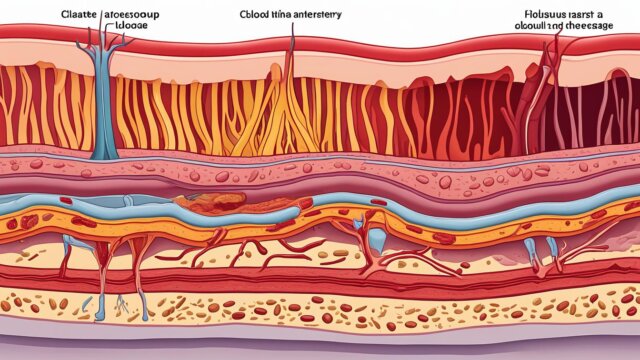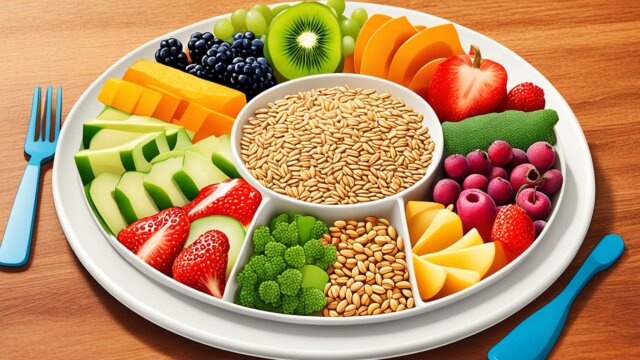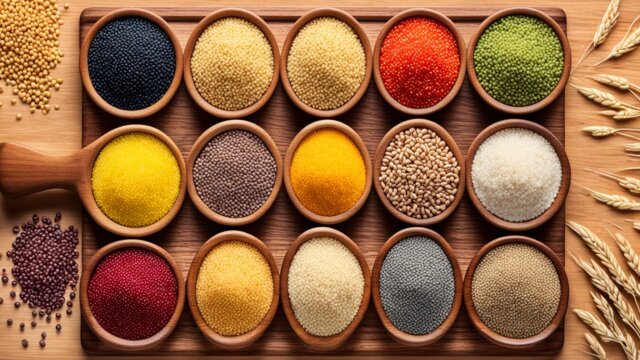FTC disclaimer: This post may contains affiliate links and we will be compensated if you click on a link and make a purchase.
About 1% of Americans have celiac disease, needing a gluten-free diet. Many more choose to eat gluten-free for other reasons. Up to 5% do it by choice, and 13% say they’re sensitive to gluten. Starting a gluten-free diet can make you feel great and keep you healthy.
Key Takeaways
- Celiac disease affects about 1% of Americans, requiring a gluten-free diet.
- Up to 5% of the population follows a gluten-free diet by personal choice.
- 13% of Americans self-report a sensitivity to gluten-containing products.
- Newly diagnosed celiac patients may face deficiencies in fiber, iron, calcium, vitamin D, and protein.
- Gluten-free packaged foods can be high in sugar and calories, so a balanced diet is important.
What is a Gluten-Free Diet?
A gluten-free diet means avoiding foods with the protein gluten. This protein is in wheat, barley, and rye. It’s key for people with celiac disease to avoid gluten because it can harm their small intestine and cause serious health problems.
Even though only 1% of Americans have celiac disease, more people follow a gluten-free diet for other reasons, like personal choice or feeling sensitive to gluten.
Understanding the Importance of Avoiding Gluten
Gluten affects many people, especially in the Western world, through celiac disease and Non-Celiac Gluten Sensitivity. For those with celiac disease, gluten can start an immune response that damages the small intestine. This can lead to belly pain, nausea, bloating, or diarrhea. People with gluten sensitivity might also have stomach issues, feel tired, get headaches, or have skin rashes from eating gluten.
Prevalence of Gluten-Free Diets
Even though celiac disease and gluten sensitivity aren’t common, more people are choosing gluten-free diets. This is due to health benefits, more gluten-free products, and thinking gluten-free eating helps with weight loss.
But, cutting out gluten can mean missing out on important nutrients from whole grains and other foods. These nutrients are key for staying healthy and preventing diseases.
For a healthy gluten-free diet, focus on foods that don’t have gluten. This includes fruits, veggies, lean meats, and gluten-free grains like rice, soy, corn, potato, and bean flour. It’s also important to watch out for gluten in foods, read labels carefully, and use separate kitchen tools to avoid gluten by mistake.
Condition | Prevalence | Symptoms |
|---|---|---|
Celiac Disease | 1% of the population | Damage to the small intestine, belly pain, nausea, bloating, diarrhea |
Non-Celiac Gluten Sensitivity (NCGS) | 0.6% – 13% of individuals | Bloating, constipation, diarrhea, fatigue, gas, stomach pain |
Wheat Allergy | 65% of children outgrow it by age 12 | Skin rashes, headaches, sneezing |
Benefits of a Gluten-Free Diet
Going gluten-free can help people with celiac disease or gluten intolerance. It means saying no to gluten in wheat, barley, and rye. This can make your gut feel better and might even help you lose weight.
Improved Digestive Health
For those with celiac disease, a gluten-free diet can reduce inflammation and improve how well your body absorbs nutrients. About 1% of people in the U.S. have this disease, but many might not know it. Nonceliac gluten sensitivity affects 0.5% to 13% of people, causing symptoms like bloating and tiredness.
Potential Weight Loss
Some folks say they lost weight on a gluten-free diet, but the science is not clear on this. Cutting out gluten can mean eating fewer calories and choosing healthier foods. It also means eating more fruits, veggies, and gluten-free grains, which are good for you.
A gluten-free diet can be a big help for those with celiac disease or gluten intolerance. It can make your stomach feel better and might help you lose weight. But, make sure your diet is full of all the nutrients you need for good health.
Gluten-Free Foods
Going gluten-free doesn’t mean you can’t enjoy food. There are many gluten-free foods that are tasty and healthy.
Naturally Gluten-Free Foods
Start with fresh, whole foods that don’t have gluten. You can eat lots of naturally gluten-free veggies, fruits, beans, nuts, seeds, fish, and lean meats.
Grains and Flours
There are many gluten-free grain alternatives like quinoa, brown rice, and wild rice. You can also choose from buckwheat, sorghum, tapioca, millet, amaranth, teff, arrowroot, and gluten-free oats. But, avoid gluten-containing grains like whole wheat and spelt.
For gluten-free flours, try almond, coconut, and chickpea flour. They’re great for cooking and baking instead of wheat flour.
Naturally Gluten-Free Foods | Gluten-Containing Grains to Avoid |
|---|---|
Vegetables, Fruits, Beans, Nuts, Seeds, Fish, Lean Meats | Whole Wheat, Wheat Berries, Graham, Bulgur, Farro, Farina, Durum, Kamut, Bromated Flour, Spelt |
Gluten-Free Grains: Quinoa, Brown Rice, Wild Rice, Buckwheat, Sorghum, Tapioca, Millet, Amaranth, Teff, Arrowroot, Gluten-Free Oats | Gluten-Free Flours: Almond, Coconut, Chickpea |
A gluten-free diet can be tasty and healthy. It offers many naturally gluten-free foods for your health and wellbeing.
“A gluten-free diet is recommended for individuals with celiac disease and non-celiac gluten sensitivity.”
Learn about gluten-free grains and flours to try new foods. Enjoy a naturally gluten-free lifestyle.
Gluten-Containing Foods to Avoid
When you’re on a gluten-free diet, you need to avoid foods with gluten. Gluten is a protein in wheat, barley, rye, and some grains. It’s key to avoid these foods if you have celiac disease, wheat allergies, or non-celiac gluten sensitivity (NCGS). Gluten can cause symptoms like diarrhea, gas, and bloating.
Common grains to skip include wheat, barley, rye, triticale, spelt, and kamut. You should also avoid foods made from these grains. This means no bread, pasta, certain condiments, baked goods, snacks, or some drinks.
Gluten-Containing Foods to Avoid | Gluten-Free Alternatives |
|---|---|
Wheat-based products (bread, pasta, cereals) | Gluten-free grains (rice, quinoa, buckwheat, corn) |
Barley (including malt) | Gluten-free flours (almond, coconut, tapioca) |
Rye | Gluten-free oats (if tolerated) |
Triticale | Fruits, vegetables, proteins, nuts, and seeds |
For a safe and healthy gluten-free diet, always read food labels. Choose foods like fruits, vegetables, legumes, animal proteins, nuts, seeds, and healthy fats. Safe gluten-free brands include Simple Mills, Purely Elizabeth, and Jovial Foods.
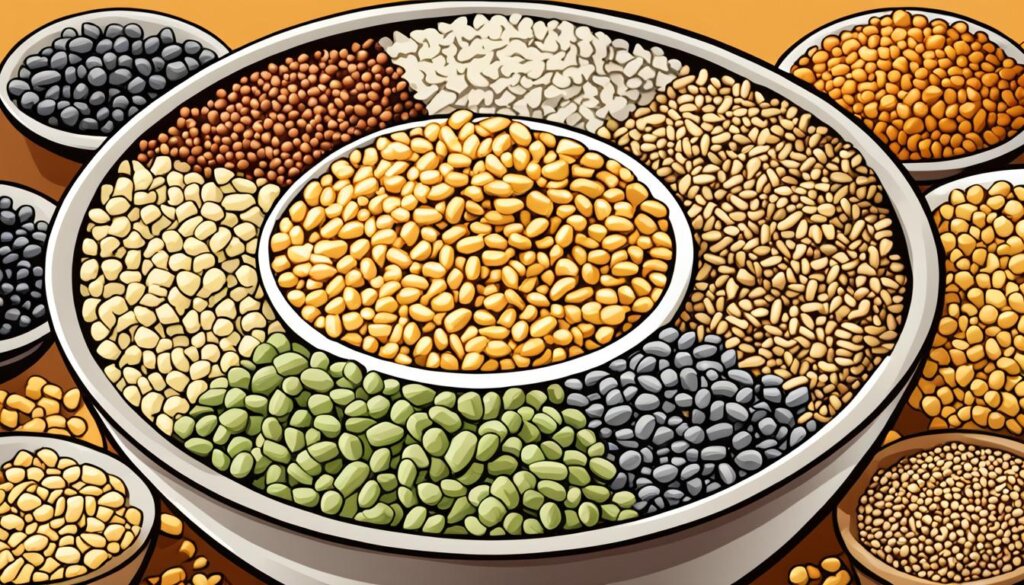
Eating out can be tough on a gluten-free diet, but it’s doable. Just pick the right menu items and talk to the restaurant staff. Go for protein, gluten-free grains, and veggies. Salads or grain bowls are good choices.
“Following a gluten-free diet can be expensive, but costs can be reduced by focusing on healthy, naturally gluten-free foods like beans, rice, and seasonal produce.”
Pay attention to gluten in foods and choose gluten-free options. This way, you can handle your gluten intolerance and live a healthy life.
Reading Food Labels
Following a gluten-free diet means you need to pay close attention to food labels. Companies must list common allergens like wheat, but they don’t have to say if there’s gluten. You should check the ingredients for gluten, like wheat, barley, rye, or malt.
Identifying Hidden Sources of Gluten
For a gluten-free diet, look for the “gluten-free” label on products. The Gluten-Free Certification Organization (GFCO) says a product can’t have more than 10 parts per million (ppm) of gluten. The FDA allows less than 20 ppm. But, “wheat-free” doesn’t always mean gluten-free, as it could still have gluten from rye or barley.
Food labels can be tricky to understand, especially for those on a gluten-free diet. A strict gluten-free diet is the only way to manage celiac disease and non-celiac wheat sensitivity (NCWS). “Gluten-free” labels and voluntary advisory statements are safe for people with celiac disease.
Labels saying “may contain wheat” or “processed in a facility/on equipment that processes wheat” aren’t reliable for gluten-free safety. Gluten can be found more often in products with oats and advisory statements. So, only eat oats that are labeled “gluten-free.”
For alcoholic drinks, “gluten-free” labels are okay for a gluten-free diet. But “gluten-removed” or “processed to remove gluten” labels are not safe for celiac disease. Wine, fruit cider without barley malt, and distilled liquor are gluten-free. But beer and malted drinks contain barley.
Understanding gluten-free labels can be hard, but with the right knowledge, you can avoid gluten in your diet. It’s a good idea to talk to a GI expert dietitian before starting a gluten-free diet for advice and guidance.
Gluten-Free Diet
Meal Planning and Preparation
Switching to a gluten-free diet means planning meals carefully. Focus on foods that don’t have gluten. These include fruits, veggies, eggs, fish, meat, and milk. You can also use gluten-free breads and pastas, but try to use whole foods more often.
Here are some tips for planning gluten-free meals:
- Use grains and flour like quinoa, rice, corn, and almond flour.
- Try different fresh, seasonal produce to make your meals tasty and healthy.
- Choose lean proteins like poultry, fish, and beans for balanced meals.
- Learn about gluten-free substitutes and cooking methods to make your favorite dishes again.
- Batch cook or prep ingredients early to make gluten-free meals easier.
By focusing on foods without gluten and planning ahead, you can eat well and stay healthy. More stores and restaurants now offer gluten-free choices, making it easier to eat out or at home.
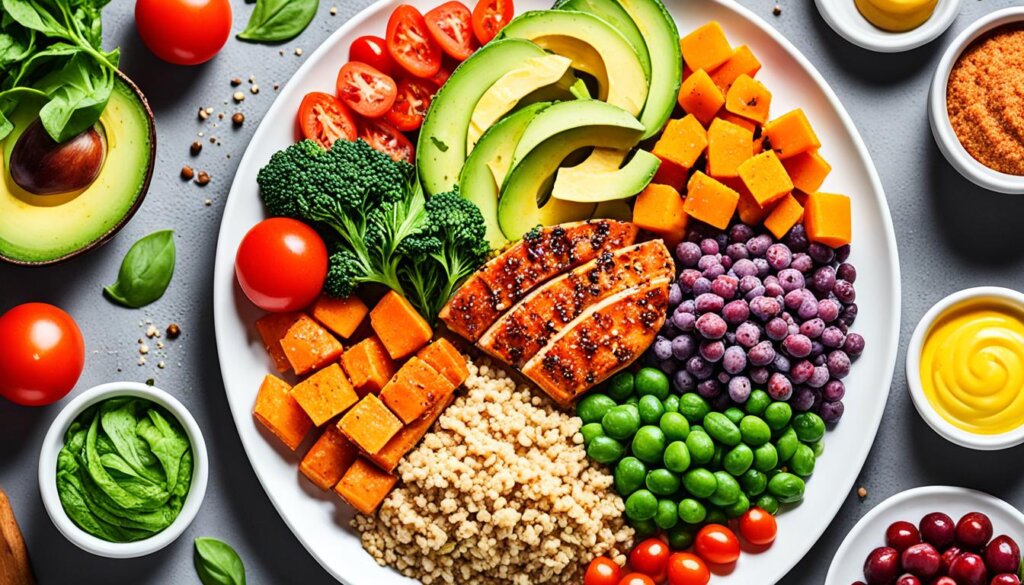
Dining Out on a Gluten-Free Diet
Going out to eat gluten-free can seem hard, but it doesn’t have to be. With some knowledge, you can eat out without worry. Knowing what to do can make eating out easy and fun.
When you’re eating out, ask about the food’s ingredients and how it’s made. Gluten can be in things like sauces and dressings, or even on shared surfaces. Tell the server and chef about your gluten-free needs to help make sure you get a safe meal.
- Choose finer dining places because they can usually make special meals.
- Call the restaurant before you go to talk about your meal choices and any worries.
- Plan your meals for less busy times to get better service.
- Tell people about your diet needs and ask lots of questions about the food.
At social events, like parties or family dinners, talk about your gluten-free diet early. It’s okay to bring your own gluten-free food to make sure you can eat safely.
Following these tips can really help you eat safely at gluten-free restaurants. But, remember, there’s always a chance of gluten getting into your food. With care and creativity, you can still enjoy eating out and being with friends without worrying about your health.
Potential Nutritional Deficiencies
Going gluten-free can be tough for getting enough nutrients. People with celiac disease might not get enough vitamins and minerals because their bodies can’t absorb them well. They might lack fiber, iron, calcium, vitamin D, and protein.
Switching to a gluten-free diet can make you eat differently, which might mean you get fewer nutrients. Gluten products are often made with extra nutrients, but gluten-free ones aren’t always the same. Also, people with celiac disease might not be able to digest lactose, which could lead to not getting enough calcium, magnesium, and vitamin D.
Monitoring Nutrient Intake
It’s key to keep an eye on what you eat to make sure you’re getting all the nutrients you need, especially if you have celiac disease. Good sources of vitamins and minerals include meat, poultry, fish, eggs, dairy alternatives, leafy greens, seeds, nuts, beans, and some fruits. Gluten-free grains like amaranth, quinoa, and brown rice are also good for fiber.
Eating a variety of whole foods and cooking them in ways that keep nutrients in is a good idea. Eating lots of colorful fruits and veggies helps you get many vitamins and minerals. You might also need vitamin D supplements, especially if you live in a place with little sunlight.
Nutrient | Celiac Disease Impact | Recommended Daily Intake | Safe Upper Limits |
|---|---|---|---|
Iron | 6-82% of adults and 12-82% of children with newly diagnosed celiac disease | 8-18 mg for adults | No specific upper limit established |
Vitamin B6 | No specific data provided | 1-2 mg for adults | 50-100 mg per day |
Vitamin A | No specific data provided | 2000-10,000 IU per day for adults | 10,000 IU per day |
Vitamin D | Potential deficiency due to lactose intolerance | 400-600 IU per day | 1000-4000 IU per day |
It’s important to watch what you eat and stick to a balanced gluten-free diet to stay healthy and avoid problems later on.

Gluten-Free Recipes
Living gluten-free doesn’t mean you can’t enjoy tasty meals and treats. There are many gluten-free recipes out there. They cover main dishes, side dishes, baked goods, and desserts. By trying new flours and grains, you can make lots of gluten-free meals and snacks.
Check out a wide range of gluten-free recipes You’ll find quick breakfasts, lunches, and even desserts that everyone will love.
Find recipes that taste great and are good for you. The average rating for gluten-free recipes is 3.23 out of 5. You can find everything from zesty salads to rich chocolate cake that’s gluten-free.
Get creative with gluten-free cooking and baking. Try new techniques and ingredients. This way, you’ll make delicious gluten-free meals and treats that everyone will enjoy.
Recipe | Votes | Rating | Prep Time | Cook Time |
|---|---|---|---|---|
Thanksgiving Bacon Wrapped Onion Rings with Sriracha Honey Glaze | 0 | 0 | 30 minutes | 1 hour 30 minutes |
Bacon-Wrapped Sausage Stuffed Jalapeño Poppers | 0 | 0 | 10 minutes | 45 minutes |
Baked Caramel Apple French Toast | 0 | 0 | N/A | N/A |
Baked Sweet Potato Wraps with Egg and Avocado | 0 | 0 | N/A | N/A |
Canadian Bacon Fried Rice with Pineapple | 0 | 0 | N/A | N/A |
Check out this amazing collection of gluten-free recipes. They make eating well easy and delicious.
Gluten-Free Snacks and Treats
Following a gluten-free diet doesn’t mean you have to give up your favorite snacks and treats. There are many tasty gluten-free options, from crunchy snacks to sweet desserts. Always check the labels for the “gluten-free” label to avoid hidden gluten.
For a quick snack, try Savor By Suzie’s gluten-free pretzels at $5.29 per bag. Or, enjoy Artisan Tropic’s Cassava and Plantain Chips for about $4.50. Lil Bucks Sprouted Buckwheat Crunch and Clusterbucks are also great, at $6.99 for a 6 oz bag.
For something sweet, Undercover Snacks offers quinoa and chocolate snacks for $3.99. Emmy’s Organics has coconut-based cookies for $5.99, and Real Cookies range from $3.49 to $7.00. Choomies Macaroons and Brownies are another great choice, at $5.00 for 7 cookies.
Chewy treats like Michele’s Granola and Purely Elizabeth granola are also gluten-free. They cost $7.99 and $7.49 for a 12 oz bag, respectively. Xochitl tortilla chips offer a gluten-free crunch, priced from $4.50 to $6.00.
Always read labels carefully when choosing gluten-free snacks and treats. With so many options, you can enjoy your favorite snacks while staying gluten-free.
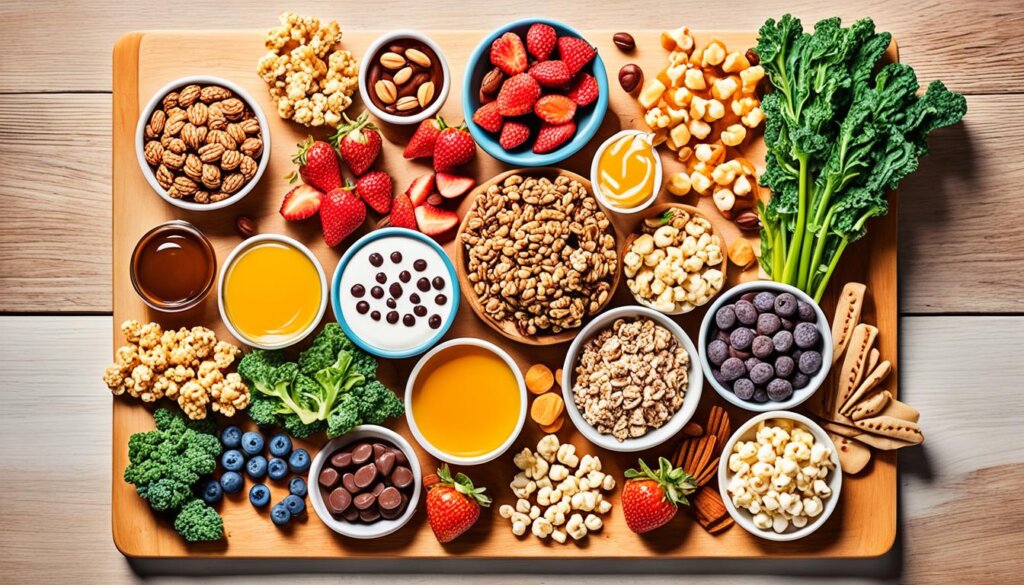
You can also make your own gluten-free snacks at home. Use ingredients that are safe for your diet and follow gluten-free recipes. This way, you can make snacks that are both tasty and healthy.
Gluten-Free Snack | Price |
|---|---|
Savor By Suzie Gluten-Free Pretzels | $5.29 per bag |
Artisan Tropic Cassava and Plantain Chips | $4.50 for a 4.5 oz bag |
Lil Bucks Sprouted Buckwheat Crunch and Clusterbucks | $6.99 for a 6 oz bag each |
Undercover Snacks (quinoa and chocolate snacks) | $3.99 for a 2 oz bag |
Emmy’s Organics (coconut-based cookies) | $5.99 for a 6 oz bag (about 9 cookies) |
Real Cookies | $3.49 to $7.00 per pack |
Choomies Macaroons and Brownies | $5.00 for a 4.93 oz pack (7 cookies) |
Michele’s Granola | $7.99 for a 12 oz bag |
Purely Elizabeth Granola | $7.49 for a 12 oz bag |
XoChitl Tortilla Chips | $4.50 to $6.00 for a 12 oz to 16 oz bag |
Always read labels carefully and choose certified gluten-free products for a safe and fun snack experience. With so many choices, you can enjoy your favorite snacks while keeping a gluten-free diet.
Support and Resources
Going gluten-free can be tough, but there’s lots of help out there. You can join a local gluten-free support group or find online communities for advice and friends. Talking to a dietitian who knows about gluten-free diets is also super useful, especially if you have health issues.
The Gluten Intolerance Group is a top spot for gluten-free support and info. They have programs like support groups, educational stuff, and a certification program for gluten-free foods.
For gluten-free dining, BIBIBOP Asian Grill is a great choice with their totally gluten-free menus. The Generation GF Magazine also has cool stuff, like the Winter 2023 issue, with tips for families with gluten-intolerant members.
Staying on a gluten-free diet means being careful, especially when eating out during the holiday season. By connecting with the gluten-free community and using resources, you can make your gluten-free journey easier and healthier.
Conclusion
Starting a gluten-free diet is a big step, but it has many benefits. It helps those with celiac disease, gluten sensitivity, or who just prefer it. You’ll learn to avoid gluten, find gluten-free foods, and handle eating out and social events. This way, you can live a healthy, happy life.
The global gluten-free products market includes many types like bakery items, pizzas & pastas, and cereals & snacks. The Food Allergen Labeling and Consumer Protection Act of 2004 set rules for gluten-free labels. More U.S. adults are trying to avoid gluten, making the gluten-free market grow a lot from 2006 to 2020.
The gluten-free diet has its challenges, like possible nutrient shortages and high costs of gluten-free foods. But, it also brings many benefits like better digestion, weight loss, and overall health. By going gluten-free and staying informed, you can make this change easy and enjoy a better life.
FAQ
What is a gluten-free diet?
A gluten-free diet means avoiding foods with gluten. Gluten is in wheat, barley, and rye. It’s key for those with celiac disease to avoid gluten to prevent serious health problems.
How common is a gluten-free diet?
About 1% of Americans need a gluten-free diet for celiac disease. More people choose it for personal reasons or gluten sensitivity. Up to 5% of people say they follow a gluten-free diet and 13% claim gluten sensitivity.
What are the benefits of a gluten-free diet?
Going gluten-free can help with digestion for those with celiac disease or gluten sensitivity. It reduces inflammation and improves nutrient absorption. Some people also see weight loss, though studies are mixed.
What foods are allowed on a gluten-free diet?
You can eat foods like veggies, fruits, beans, nuts, seeds, fish, and lean meat. For grain lovers, rice, quinoa, millet, and buckwheat are gluten-free. Gluten-free flours from almonds, coconut, or chickpeas are also good for cooking and baking.
What foods should be avoided on a gluten-free diet?
Avoid foods with gluten like wheat, barley, rye, triticale, and malt. These are often in bread, pasta, cereals, and processed foods. Always check labels for gluten ingredients.
How can I identify gluten-free products when shopping?
Reading food labels is key for gluten-free shopping. Look for the “gluten-free” label. Check the ingredients list for gluten, like wheat, barley, rye, or malt.
How can I adjust to a gluten-free lifestyle?
Changing to a gluten-free diet means planning meals and snacks. Focus on foods that are naturally gluten-free. Use gluten-free breads and pastas but try to eat whole, unprocessed foods too.
How can I dine out safely on a gluten-free diet?
Dining out gluten-free can be tricky but doable. Ask about ingredients and how food is prepared. Gluten can be in sauces, dressings, and cooking surfaces. Look for gluten-free options and talk to your server about your needs.
What are the potential nutritional deficiencies associated with a gluten-free diet?
Celiac disease can make it hard to get nutrients from food. You might lack fiber, iron, calcium, vitamin D, and protein. A dietitian can help make sure you get all the nutrients you need on a gluten-free diet.
Where can I find support and resources for a gluten-free lifestyle?
Going gluten-free can be tough, but there’s lots of support out there. Join gluten-free groups or online forums for advice and friends. A dietitian who knows about gluten-free diets can also be a big help, especially if you have celiac disease.


